What about Rabbit Holes and Amonute Matoaka “Pocahontas”? As I sat down to go through my emails and social media notifications (I often laugh when I check in on Facebook for work) I saw a note from Abby Glann, Leader Liaison at WikiTree, telling me she has chosen the profile of Amonute Matoaka “Pocahontas” to be used as an example profile coming up in a week or two.
Setting out to do anything but what I planned
Forget my wonderful and patient (you know you are) clients, forget my research, push a blog post to the back (the blog is the first thing that gets pushed back to accommodate everything else) forget everything else, drop it all to run have a look at the state of this profile? 4 hours later I am still fixing stuff, piddling about, sending messages to project members about this looming deadline and the need to work collaboratively to make this profile sing.
To Blog or not to Blog
Blogging is something I enjoy. I love to Blog, to write (if you can call my butchery of the english language “writing”) and to share the “what’s going ons” of my genetic genealogical pursuits. In a year that has seen regular Genealogical Bloggers pull up stakes and move on from blogging I jumped in with so many feet and inches and centiMorgens that I am chest high in the muck of it – the genealogy blogging world. And LiveCasting – that too can be considered a blog. I don’t see myself jumping out either.
I have been pushing this blog thing to the back of everything. When Abby sent the note about the Example Profile, I thought I would just have to wait to write til another day. Enough!
What are all of these Rabbit Holes? Here are a few…
My most regular client
for whom I work a specified amount of hours a month – working the DNA and the Genealogy looking to make connections for him as I find them and or as they appear. He drops me a note when he gets a note from someone wanting to know if they are connected a certain way via DNA. They have the same surname in common, it must be it! 9 times out of ten it isn’t and I get to spend some time in the primordial ooze that is his family DNA and his genealogical paper trail to show the hows and whys of “not that route”or the excited exclamation of YOU ARE RIGHT! and we need to do this and this and…Doing work for him every month is like the part of the doughnut you save for last whether it be the filling or the icing, there is always something fun to be had and it can be had at anytime – no calorie restrictions (I have been craving doughnuts this week).
One of my clients sent me an email from the Ukraine
Yes he took off on his own to investigate some of the information we have turned-up about his family. This one is interesting in that it is Jewish Genealogy rife with a demographic that makes genetic genealogy hard – Endogamy. The practice of marrying within ones own community or family group. This case is exacerbated by the living descendants protective nature of the past and the unwillingness to do tests to help find an adoptee from the 1910’s. “Yes, we must keep our 100 year old secrets hidden, even if we don’t know what they are ourselves”.
Betty Jean
Oh yes Betty Jean is still on the front burner because we need to track down her mother. Yes I have been waiting for my favorite genealogical investigator to emerge unscatheed from some very hard family issues. Why do I feel guilty if I work without her? No, it’s not that I feel guilty, it’s because on this we are a team and I feel like I am walking without one of my legs. There is no rush on this for my part at all. Take care of family and I will see you soon.
New client with boxes
She actually said she was bringing shoeboxes with her to our first meeting. She is a professional who just doesn’t have time to learn how to do Genetic Genealogy. She is a good and tenacious researcher and a joy to work with. Sent her a note to ask her Ancestry DNA matches to download their DNA raw data and upload it to GEDMatch and zoom she was off. I am working the analysis and working the paper trail as they appear.
AND MORE! <breath> At this point I just had that stomach turning feeling of I really should be working and not blogging <STUPID FEELING>
WikiTree
Of course there is always work to do on WikiTree since I use WikiTree as my Genealogical Program and it is an integral genetic Genealogy tool in my genealogy toolbox. Did I mention Chris Whitten came back to me with the answer to a question I asked him while at Roots Tech? Hey! He has been busy revamping the GEDCOM apparatus of WikiTree among other things! The question?
How many DNA connected profiles do we have on WikiTree?
Drum Roll Please…
“A new number just went live on our home page: 3,027,628.
As in: “Our shared tree includes 15,105,620 profiles (3,027,628 with
DNA test connections) edited by 453,232 genealogists from around the
world.”
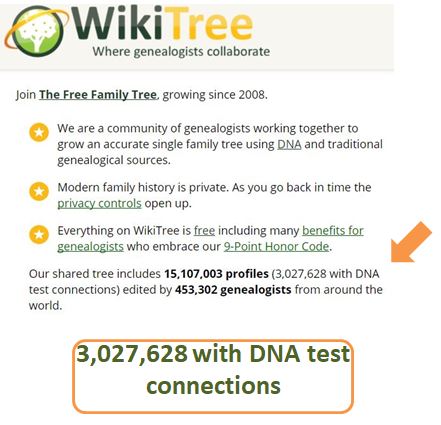
…The total number of DNA test connections is up around five or six million….The total number of test-takers is about 53,000.
This is really very cool. A stat that really says something about our commitment and success in growing a shared, *accurate* family tree. Afamily tree that someday will be confirmed with DNA.” -Chris Whitten
What does a “Test Connection” on WikiTree mean?
Every time a WikiTreer adds their DNA test information to WikiTree, WikiTree adds that information to the WikiTreers profile as well as to that of every profile in the limbs of WikiTrees great big ole shared tree, that that test would affect. So, if I add that I have taken a FTDNA auDNA (Family Finder Test) to my WikiTree Profile, WikiTree will post that DNA Connection to every single profile of my family – siblings, parents, cousins, grand parents, great grandparents – back to my 64, 4th great grandparents will show my test information. All following how I. you, we, inherit auDNA.
Why is this important and why is it a connection? Let’s say Julie Blue is hunting around the internet for information on her great great great grandfather, Dempsey Gaulden. Because WikiTree is cutting edge on it’s search engine optimization, when she searches for Dempsey, his WikiTree Profile pops-up at the top of her search engine results page.
She bounces over to his profile and sees all of the information that this ‘Mags Gaulden’ has done on he and his family, “Oh wow I never knew Dempsey raced horses in New Orleans!” she exclaims. Then her eye falls on this list, “DNA Connections” prominently displayed at the top right of the page: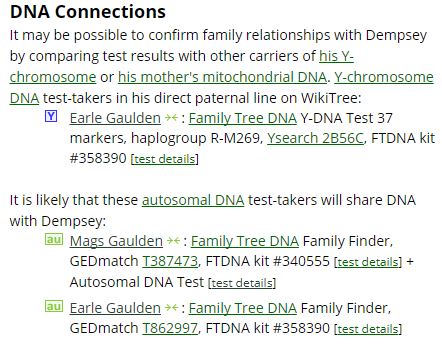
“Oh My Word! I tested my DNA, I wonder if we match?” And, “Wow, My Uncle jeb Gaulden – his y-DNA should match this Earle!” Julie Blue spends the rest of HER afternoon down the rabbit hole that is the GEDMatch/WikiTree integration. She uploads her raw data to GEDmatch where she finds Mags and Earle and others on wikiTree from her list of matches at GEDMatch.
Chris just posted this explanation – way more…techie than my answer. What you don’t like Melodrama? <southern hand across southern forehead>
“What exactly is a DNA test connection? It’s where we post a notice on a WikiTree profile that says there is a DNA test that might be useful for confirming or rejecting relationships to that person. For Y-chromosome tests it means the test-taker is on the same paternal line. For mitochondrial tests it means the test-taker is on the same maternal line. For autosomal tests (the most popular these days, e.g. AncestryDNA, Family Tree DNA Family Finder, 23andMe) it means that the test-taker is within eight degrees and is therefore likely to share significant segments of DNA.
The bottom line: A DNA test connection is an opportunity to try to scientifically prove what’s been established through traditional genealogy.
Every time I see a new one on a profile that I care about I get a little rush of excitement. Knowing there are three million of these around our shared tree puts a big smile on my face.” – Chris Whitten
Sound easy? It is!
ooop, I just blogged. ‘Scuse me.

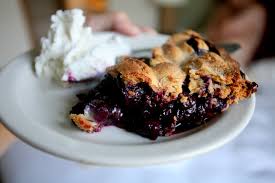
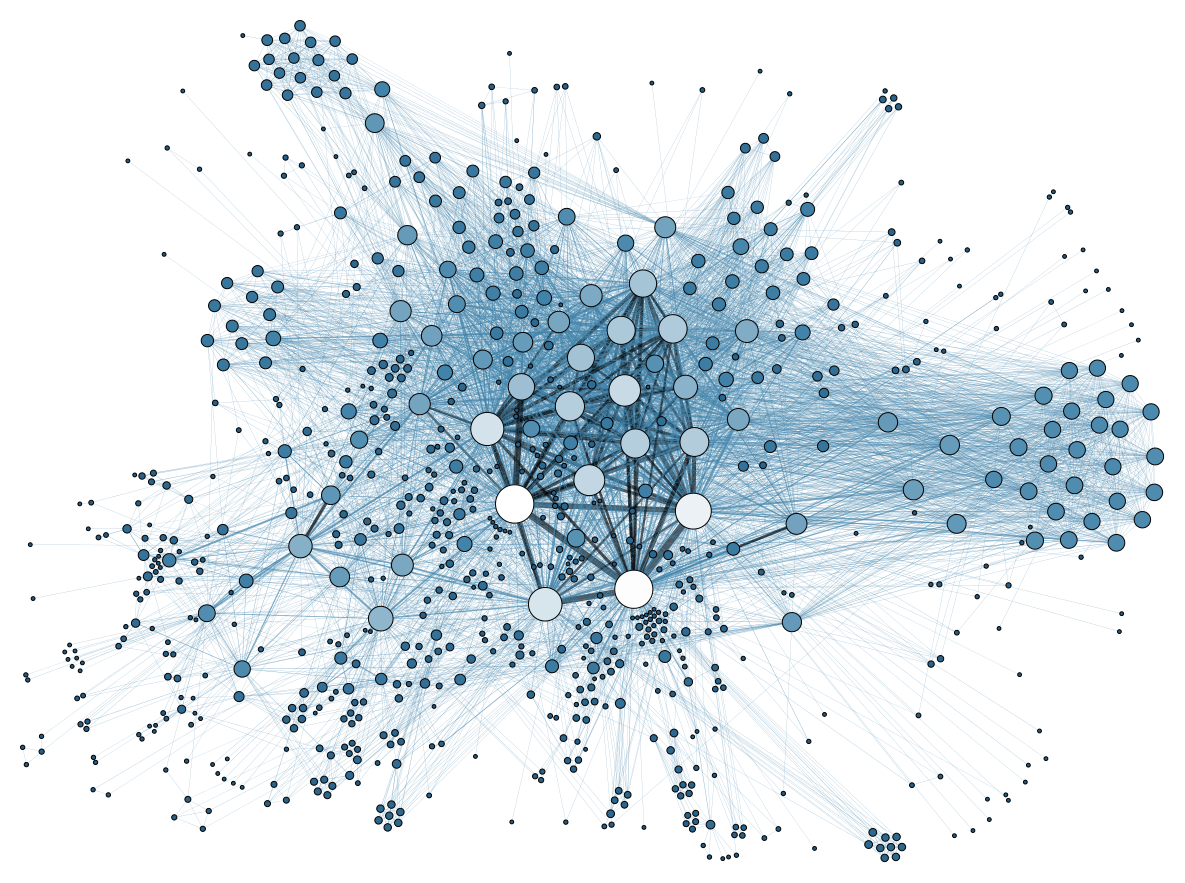
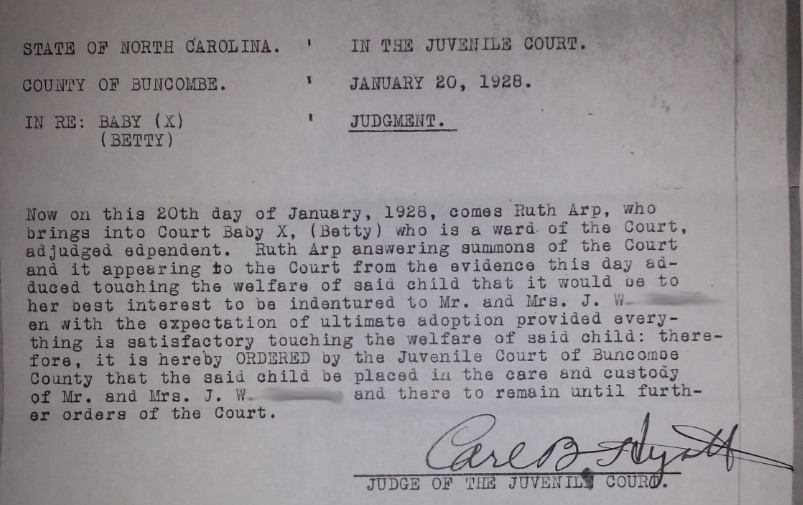
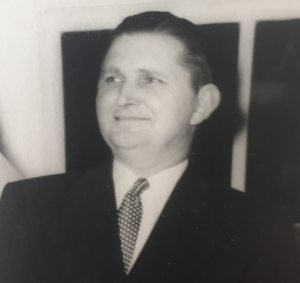 How did it happen? How did Betty Jean come about? We have no idea. It was a secret he kept to his death.
How did it happen? How did Betty Jean come about? We have no idea. It was a secret he kept to his death.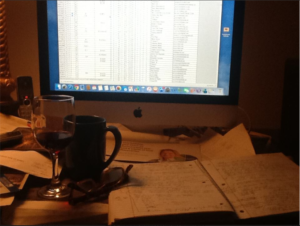
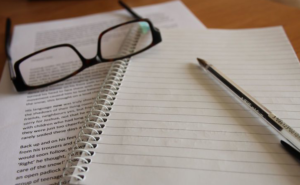 Subsequent communications from the adoption agency to Pat also gave more information on the birth mother and birth father. Like occupations, religion, height and ultimately what the cause of death was for her birth father – cancer.
Subsequent communications from the adoption agency to Pat also gave more information on the birth mother and birth father. Like occupations, religion, height and ultimately what the cause of death was for her birth father – cancer.




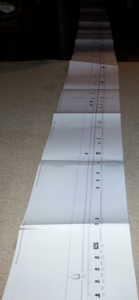 Deciphering all the intricacies of Jane’s well sourced/documented Ancestry tree was going to be one huge undertaking. To be able to use WikiTree’s Connecting abilities, DNA Tools, Relationship Finder Tools and RootsSearch integration tools I needed to be able to use Jane’s Tree in WikiTree. I started adding Betty Jean’s top DNA matches to WikiTree based on Jane’s research.
Deciphering all the intricacies of Jane’s well sourced/documented Ancestry tree was going to be one huge undertaking. To be able to use WikiTree’s Connecting abilities, DNA Tools, Relationship Finder Tools and RootsSearch integration tools I needed to be able to use Jane’s Tree in WikiTree. I started adding Betty Jean’s top DNA matches to WikiTree based on Jane’s research.